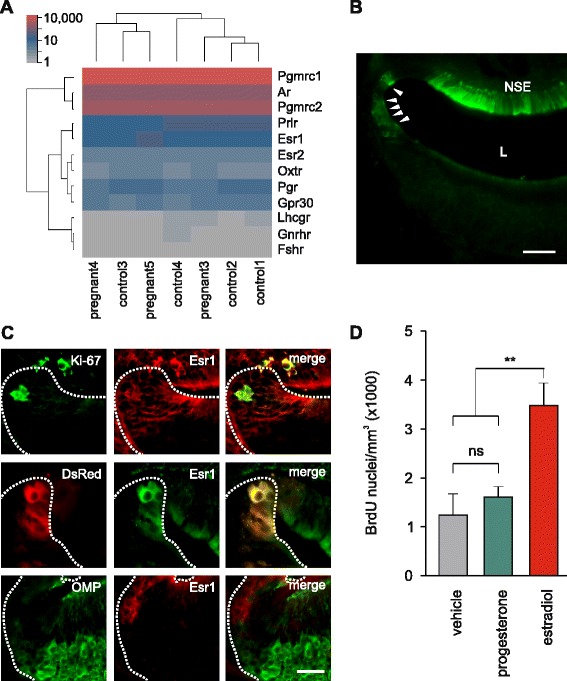Fig. 8.

Vomeronasal organ (VNO) neurogenesis is facilitated by estrogen. (a) A heat map of hormone receptor gene expression in the VNO, from high-throughput RNA-sequencing (RNAseq) data. Expression values are in normalized counts. Mean Esr1 expression is 144 normalized counts and mean Esr2 expression is 18 normalized counts, neither are differentially expressed between pregnant and control mice. Pgrmc1, Pgrmc2, progesterone receptors membrane-component 1 and 2; Ar, androgen receptor; Prlr, prolactin receptor; Esr1, estrogen receptor α; Pgr, progesterone receptor; Esr2, estrogen receptor β; Gpr30, G-protein coupled estrogen receptor 1; Oxtr, oxytocin receptor; Lhcgr, luteinizing hormone/choriogonadotropin receptor; Gnrhr, gonadotropin releasing hormone receptor; Fshr, follicle stimulating hormone receptor. (b) Immunolocalization of estrogen receptor α (Esr1) in a wild type C57Bl/6 female VNO coronal section. Arrowheads indicate Esr1+ cells at the lateral corners of the epithelium where neuronal progenitors congregate. NSE, Non-sensory epithelium; L, Lumen. Scale bar, 50 μm. (c) Double labeling of VNO epithelial margins with Esr1 antibody and Ki-67 antibody (top), doublecortin (Dcx)-DsRed (central), and olfactory marker protein (OMP) antibody (bottom). VNOs from C57Bl/6 females were used for Ki-67 and OMP staining. Scale bar, 25 μm. (d) Quantification of BrdU+ cells in the VNOs of ovariectomized Dcx-DsRed females after a 9-day treatment with either, vehicle (sesame oil), progesterone, or estradiol benzoate. One way-ANOVA: F2,24 = 9.95; **P <0.01; control vs. progesterone P = 0.761; n = 8 mice (vehicle), 9 mice (progesterone), and 8 mice (estradiol). BrdU was administered 8 h before sacrifice
